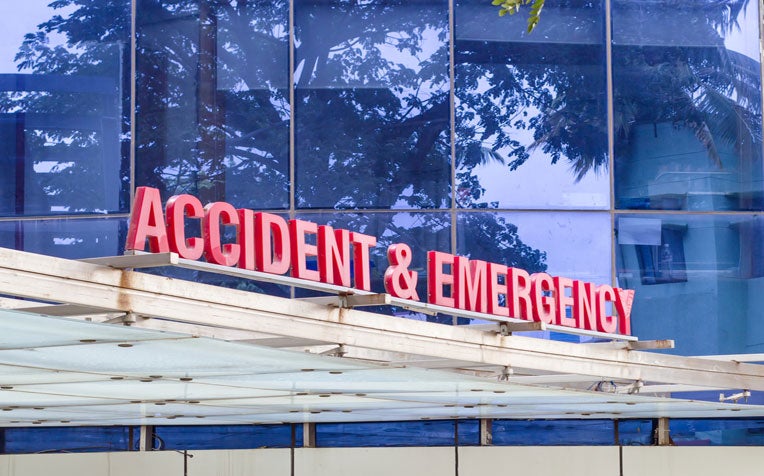
The A&E department's role is to administer treatment for emergency conditions.
Knowing what needs to be treated at the A&E can save money and time. More importantly, queues can be shortened, letting real emergencies be seen quickly.
A man slipped and fell down a muddy slope in Pulau Ubin, cutting his leg. Blood began spurting out, and he pressed down hard on the leg to stop the bleeding. But the bleeding continued. With soil and dirt likely to have entered the gaping wound, the man needed to have it cleaned and disinfected quickly to avoid infection. He was also in danger of losing a lot of blood if he didn’t have the cut stitched up quickly.
“When a vein is cut, blood drips and stops quickly when pressure is applied. But when an artery is cut, blood will spurt non-stop even after pressure is applied. The person can lose a lot of blood,” said Dr Juliana Poh, Consultant, Department of Emergency Medicine, Singapore General Hospital (SGH), a member of the SingHealth group.
In the main, cuts, even fairly deep ones, can be treated at a neighbourhood clinic. But when a serious injury is involved, especially if there is also a risk of a complication arising from the accident, it is best to go to a hospital’s accident and emergency department (A&E) quickly, Dr Poh added.
Not all injuries need the attention of A&E doctors, who can be overwhelmed by far too many cases that are not life-threatening. Having to see patients who can be treated by a general practitioner (GP) or family doctor adds to the long waiting times and frustration that patients at A&Es experience.
More worrying is that people with real emergencies might not get the urgent care they need fast enough. “We don’t turn away anyone who comes to the A&E, but some see the A&E as a sort of a GP clinic plus other services,” said Dr Poh.
“Our role is to administer life-saving treatment for emergency conditions such as heart attacks, strokes, and severe injuries from accidents. We initiate treatment for acute medical conditions that require inpatient care, such as severe pneumonia and severe asthma, and life-threatening complications from haematological and oncological conditions,” she said.
Longer wait and costlier bills for non-emergency visits to the A&E
To make sure emergency cases are seen to quickly, nurses check patients for their vital signs and determine the priority of their treatment based on the severity of their illness – a process known as triage.
A senior doctor double-checks the list to make sure the patients are assigned correctly, and those with critical conditions given priority to see a doctor.
People whose conditions are not life-threatening or critical often face a long wait, and seeing their GP or family physician might be a faster and cheaper option.
A visit to the A&E costs at least $108 – a subsidised basic charge that covers consultation, investigations like urine and blood sugar tests and ECG, as well as basic drugs and nursing care.
Charges for other investigations such as CT scans and MRI scans, if they are required, are additional.
When do you need to rush to the A&E?
Falls
Treat at home
- If the person is able to stand and walk a few steps, immediately or even some hours after hurting his ankle in a fall, the injury is most likely just a sprain and not a fracture.
- By following the RICE method – Rest (to avoid putting further pressure on the injury), Ice (to limit swelling), Compression (with a bandage), and Elevation (of the injured limb above the heart wherever possible to limit swelling).
- By taking oral analgesics such as Panadol to ease the pain.
- As in most cases, sprains and bruises will improve after a few days.
See a GP
- If the pain, swelling and bruising do not get better or worsen by the third day. An x-ray may be needed to rule out or confirm a fracture.
Rush to A&E
- If the person is elderly. It's best to err on the side of caution as many old people suffer from age-related degenerative disease, and an injury to the head or neck can lead to spinal cord injuries.
- If the person is on blood thinning medication, as he will be at risk of serious bleeding.
Accidental swallowing of a bone
Treat at home
- By drinking some water. Gulping rice or bread to force down a bone or small denture can worsen the injury. If the pain diminishes quickly after drinking water, it is most likely to be just a scratch or abrasion caused by the swallowed object.
See a GP
- If the bone or object is lodged in the throat as most GP s are equipped to remove small bones from the tonsil area.
Rush to A&E
- If there is persistent sharp pain in the throat or chest, causing difficulty in speaking or swallowing, and/or if there is blood in the saliva, or if the person feels breathless or faint because the bone or object has blocked the airways.
- If the object cannot be detected easily because it has moved down the throat. A nasal scope, x-ray or CT scan can help locate it.
Read on for more examples of when it is needed to head to the A&E.
Ref: R14
Contributed by


















 Get it on Google Play
Get it on Google Play